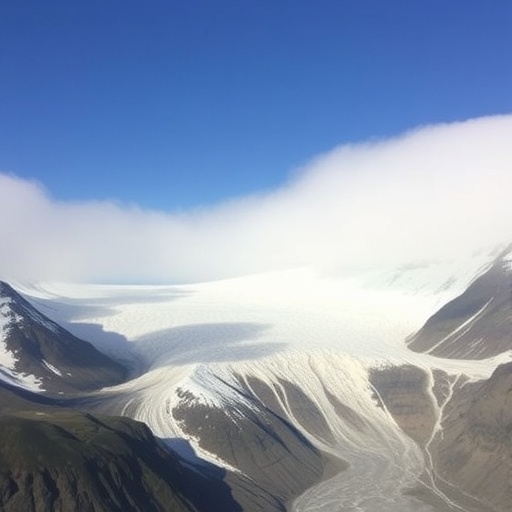In a groundbreaking study published in Nature Geoscience, University of Victoria geographer Sophie Norris and her international team have unveiled the most comprehensive global assessment yet of how rapidly glaciers shape the Earth’s surface through erosion. This research harnesses cutting-edge machine learning techniques to analyze glacial erosion rates on an unprecedented scale, providing critical insights into the processes that govern landscape evolution under ice masses and offering projections for future changes affecting more than 180,000 glaciers worldwide.
Glaciers have long been recognized as powerful agents of geological transformation. They carve majestic valleys, sculpt mountainous terrains, and redistribute sediments across continents, fundamentally altering the planet’s surface topology. Yet quantifying the speed at which glaciers erode underlying rock has remained an elusive challenge, largely due to the remote, harsh, and dynamic environments in which glaciers operate. Norris and her team have addressed this knowledge gap by collating a vast dataset and applying regression models informed by diverse environmental factors, enabling the prediction of erosion rates beyond the limited sites where direct measurements exist.
The study’s results are striking in their scope and precision. The researchers estimate that 99 percent of glaciers erode their beds between 0.02 and 2.68 millimeters annually—an interval roughly comparable to the thickness of a standard credit card. This finding refines previous generalizations and underscores the significant variability in glacial erosion rates depending on local geophysical and climatic conditions. The incorporation of machine learning allowed the scientists to parse complex interactions between glacier dynamics and environmental variables with greater accuracy than traditional methods.
One of the key revelations of this research is the intricate interplay of factors driving erosion beneath glaciers. Contrary to prior assumptions that simplified erosion drivers, the analysis reveals that variables such as temperature, basal water availability, regional lithology, and geothermal heat flux all exert pronounced influence. Temperature affects ice viscosity and basal sliding speed, whereas the presence and pressure of subglacial water can either lubricate glacier flow or promote enhanced abrasion and plucking of bedrock. The type and hardness of the underlying rock determine its susceptibility to mechanical and chemical weathering, while geothermal heat influences basal melting and subglacial hydrology, collectively shaping erosion intensity.
Measuring erosion directly beneath active glaciers poses enormous technical difficulties. Glaciers are often located in remote, inhospitable locations where fieldwork is limited by logistical, environmental, and safety constraints. This study circumvents these hurdles by integrating remotely sensed data with ground-based observations and employing statistical modeling to extrapolate erosion rates across the globe. The use of machine learning ensures that the predictive models adapt to non-linear relationships and subtle correlations among environmental drivers, marking a significant advancement in the methodological toolkit of geomorphology.
Beyond academic understanding, the implications of accurately estimating glacial erosion rates are profound for environmental management and policy. For instance, landscape evolution under glaciers influences soil formation and nutrient fluxes, thus affecting biodiversity and ecosystem services downstream. Moreover, glacial erosion modulates sediment transport to rivers and oceans, impacting aquatic habitats and carbon cycling. These findings are also pivotal for infrastructure planning, particularly regarding the stable storage of long-lived nuclear waste, where knowledge of geological stability and erosion potential informs site selection and safety assessments.
The collaborative nature of the project reflects a synthesis of expertise and data sources across continents, drawing participation from institutions including the University of Grenoble Alpes in France, Dartmouth College, Pennsylvania State University, University of California Irvine, and Dalhousie University. The partnership with the Canadian Nuclear Waste Management Organization not only facilitated funding but also linked basic research to practical applications in environmental safety and resource management.
Importantly, this study signals a new horizon in the use of artificial intelligence and machine learning within Earth sciences. By embracing these technologies, scientists can unlock patterns and predictive capabilities that were previously inaccessible, especially in studies of complex, multi-factor processes like glacial erosion. This methodological innovation promises to accelerate understanding of other cryospheric and geomorphological phenomena under rapidly changing climatic conditions.
As glaciers continue to retreat worldwide due to global warming, comprehending their erosive power becomes increasingly urgent. The rates at which glaciers excavate bedrock not only influence geomorphic transformation but also have cascading effects on carbon budgets, water quality, and sea-level rise. By providing robust baseline estimates and forecasting future erosion scenarios, Norris and her colleagues equip scientists, policymakers, and communities with vital knowledge to anticipate and mitigate the consequences of a warming Earth.
The analysis provides an invaluable framework to monitor sediment dynamics and nutrient redistribution—key factors in maintaining ecosystem resilience amid environmental fluctuations. It underscores the necessity of integrating geophysical data, climatic variables, and geological context to holistically assess glacier impacts on the Earth’s surface. This approach is poised to improve predictive models of landscape change, informing conservation and adaptation strategies on multiple scales.
Ultimately, the study highlights the remarkable complexity of glacier-bed interactions. Surface ice dynamics alone cannot fully explain the pace and patterns of erosion; instead, multifaceted feedback loops involving water flow, heat, and rock characteristics shape the evolving interface. Recognizing and quantifying these intricate drivers elevate our understanding of Earth’s highly dynamic cryosphere and its vital role within the broader planetary system.
This landmark investigation represents not only a milestone in glaciology but also a testament to the transformative power of interdisciplinary science and advanced analytics. As we confront accelerating environmental change, such integrative studies will be indispensable in decoding the central questions of how and how fast Earth’s surface transforms beneath its frozen giants.
Subject of Research: Not applicable
Article Title: Drivers of global glacial erosion rates
News Publication Date: 7-Aug-2025
Web References:
https://www.nature.com/articles/s41561-025-01747-8
http://dx.doi.org/10.1038/s41561-025-01747-8
Image Credits: John Gosse, Dalhousie University
Keywords: glacial erosion, landscape evolution, machine learning, cryosphere, glacier dynamics, subglacial processes, geothermal heat flux, sediment transport, climate change, geomorphology, environmental monitoring




